RahXephon
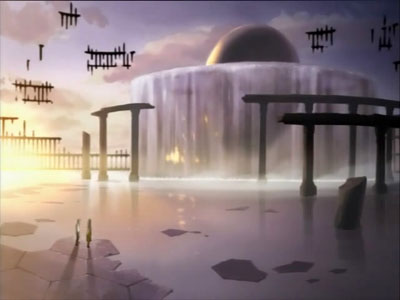
Here’s another ancient artefact unearthed during my idle excavation of anime past. RahXephon is an original anime series from the long-gone era of 2002, back when George W Bush ruled the free world with an iron fist and people thought Witch Hunter Robin was actually enjoyable. Those were simpler times. *switches on flame shield*
I enjoyed RahXephon the first time I watched it, so naturally when I recently had the chance to revisit the series, I assumed that like most good things from my (relative) childhood it would turn out to be a piece of turd. Fortunately I was proven wrong.
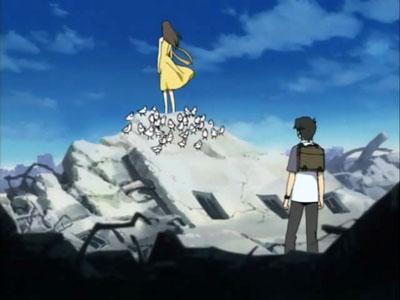
Boy meets girl
Ayato Kamina is a perfectly normal boy… Oh screw it. I’m too lazy to write a summary for this, so I shall plagiarize one from ANN:
In a world where time passes at a crawl and the blood of your neighbor runs blue, 17 year old high school student Ayato Kamina goes about his daily life within Tokyo Jupiter oblivious to the world around him, having been educated with the fact that the all civilization but Tokyo has been destroyed. But all that changes when the mysterious civilization “MU” invades his home, raining destruction down from the sky in the form of strange monsters called Dolems. The events that occur next will lead Ayato to the mysterious woman named Reika Mishima, to the truth of their existence, the discovery of what and who he is, and to the powerful angelic robot RahXephon.
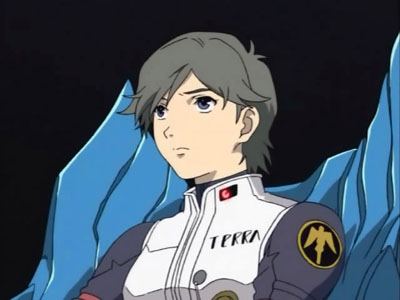
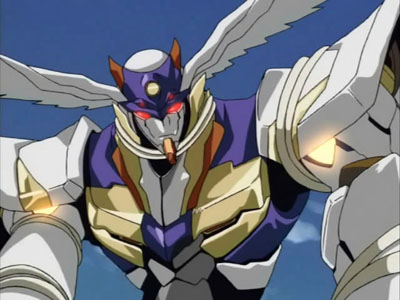
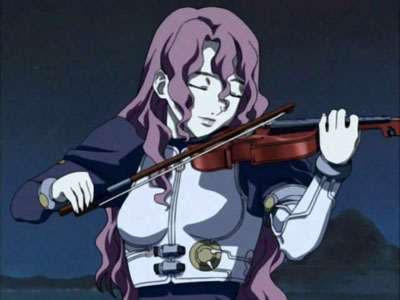
Rei + Violin = Quon
Once again invoking my arguably paradoxical belief that all anime can be mathematically derived from preceding titles, the appropriate equation for this occasion is probably: Evangelion – Judeo-Christianity + Music + Mesoamerica = RahXephon
It would be somewhat of an understatement to say that RahXephon bares striking similarities to Evangelion. The influences are unmistakeable and a compelling case can be made that RahXephon was intentionally conceived to be an improvement upon Evangelion’s framework.
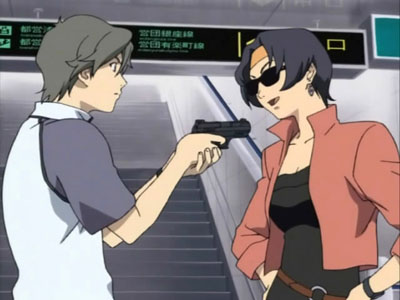
Boy meets girl… again
Let’s see here… Ayato is basically a cooler Shinji who is a gifted painter and popular with the chicks. During the attack on Tokyo, he meets Haruka Shitow, an agent working for TERRA, a paramilitary organization under the umbrella of a futuristic UN. Haruka is basically Misato except she is the female lead. After some love comedic ups and downs with the older woman, Ayato ends up at TERRA’s headquarters where he meets Quon Kisaragi, who is basically a hotter and cuter Rei, i.e. a constant source of mysticism and fanservice.
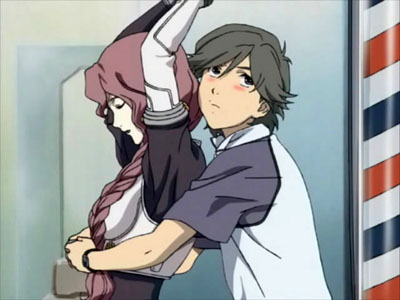
Boy meets yet another girl
The battle music in RahXephon is curiously reminiscent of Evangelion’s “Decisive Battle” and there’s a whole shopping list of other similarities that can be found between the two: a mysterious organization influencing global events, biomechanical mechas with dark secrets, ancient prophecies of world-resetting armagaddon and all the standard post-Eva existential essentials. Normally, I would be one of the first to reject these superficial similarities as merely the common features of an established genre, but RahXephon, I feel, goes beyond that.
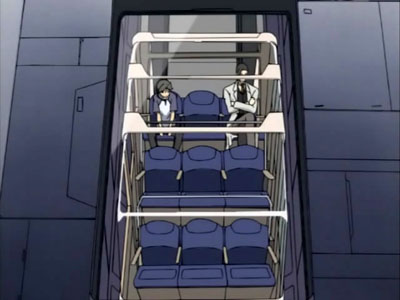
Down the Geofront.. oh wait
Remember how when you first watched Evangelion, the ending left you confused and emotionally traumatized? I believe, with little evidence beyond my gut, that RahXephon’s producers set out to recreate the complex web of emotions that Eva gave us so as to give it the proper finality that End of Evangelion failed to provide for many. It’s kind of like how fan-fiction writers write alternative endings to match their wishes for the characters, although it sounds rather lame when I put it in that context. Haha.
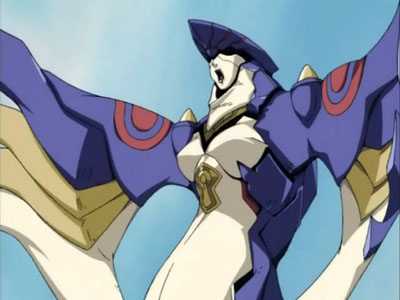
Mulian weapon
That is not to say that RahXephon is trapped in the shadows of its source of inspiration — It is a story of human emotions that stand very well on its own. Perhaps because I’m not fluent enough in the language of the heart to fully appreciate the depths of Evangelion, but I found its presentation of human psychology rather incomprehensible at times, perhaps overly avant garde for the sake of it. RahXephon has its fair share of Alice-in-wonderland moments, but somehow manages to do a better job of tying things together while remaining relevant. In that sense, RahXephon provides a much more engaging and emotional experience.
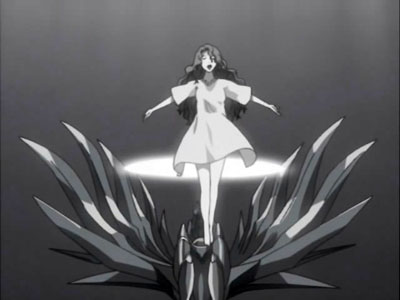
RahXephon is like a work of art, really.
Beyond its heavy use of music as an important plot device, it is also highly effective in its visuals. I think there are few episodes in any anime that left such a deep impression on me as RahXephon’s episode 19. As Ayato desperately tries to protect his childhood friend Hiroko from the attacking Mulian in an ironic gesture whose futility can only be appreciated by the audience, the entire city’s power grid became a flashing display for a young girl’s heartfelt affection. The word “goodbye” trails off into infinity and, after a moment of darkness, the city is once again lit up. A powerful and imaginative scene.
The final episode also does an excellent job in its surrealist presentation.
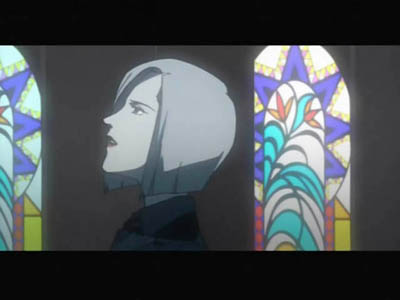
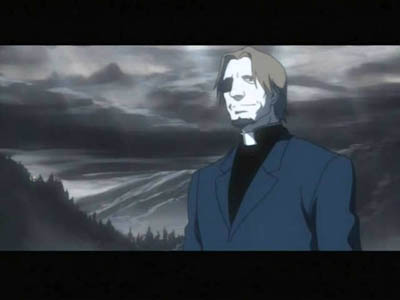
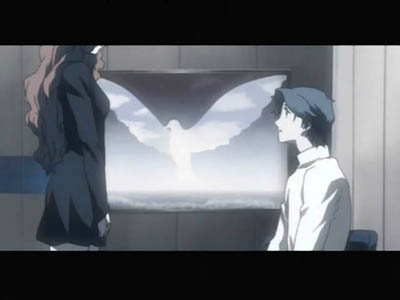
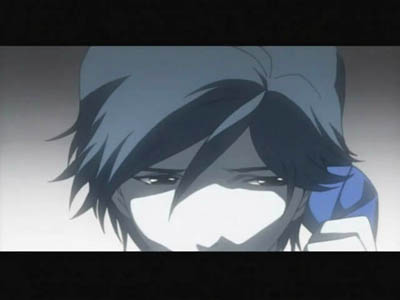
As usual, I shall end my post here in an abrupt manner before I end up spoilering the entire series. Oh yeah, Maaya Sakamoto voiced Reika Mishima, so huzzah! And with that, I leave you with a bunch of purdy pictures.
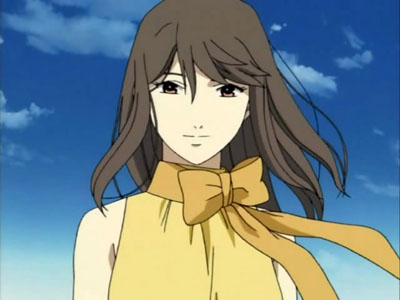
Maaya <3
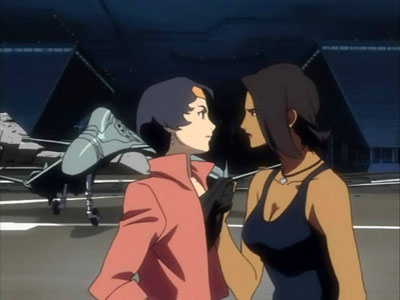
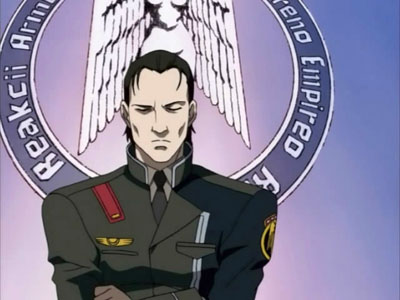
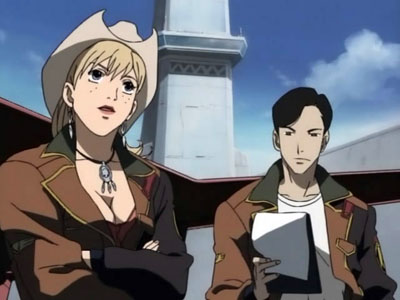
Racial diversity ftw
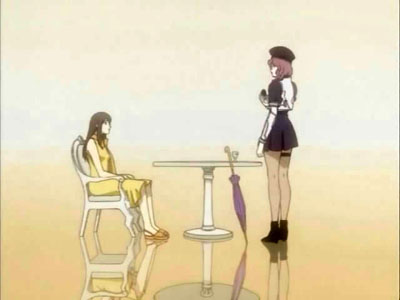
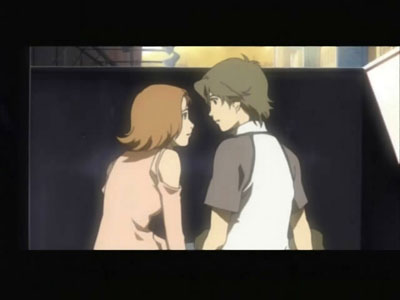
Shinji has nothing on this guy
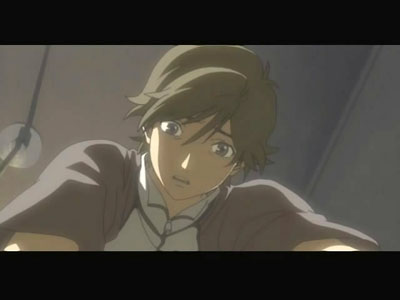
Guess the situation >_>
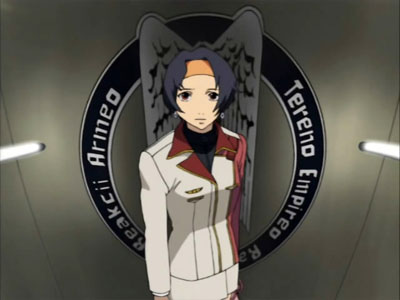
The angelic-wing motif plays rather heavily in the show
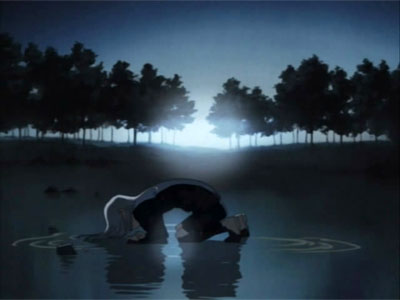
orz
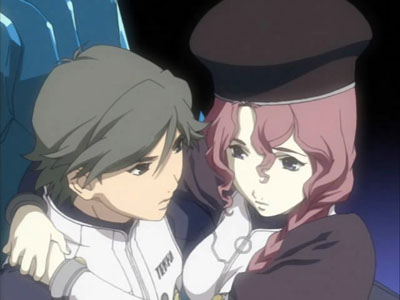
Ayato, playboy extraordinaire
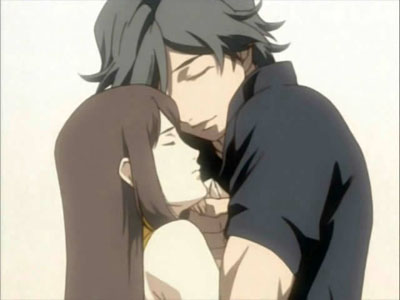
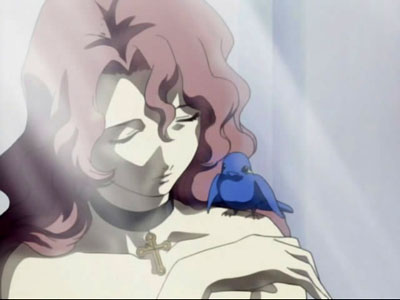
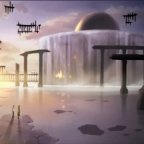





May 5th, 2009 at 9:59 pm
You know, I fully expected people who watch 2002 anime in 2009 would actually come up with something new to say. As is it’s kind of a rehash of the same things I’ve heard parroted during 1997-2004. Then again, I doubt anyone could top gothy witch girl concept since Witch Hunter Robin, so some oldies are the state of art.
But I guess you were trapped thinking about Rahxephon along the lines of Evangelion. Maybe alternatively you can give the novels a shot. They’re much better framed (and partly because, presumably, nobody read the non-existent Eva novels) in order to show off that “hey, this is Evagelion but done better^H^H^H^H^H^Hwithout pissing a lot of people off.”
May 5th, 2009 at 10:02 pm
Omo is harsh because I dissed Robin :(
To my defence, I was in 6th grade then D:
May 5th, 2009 at 10:12 pm
RahXephon has Maaya, enough said. And I don’t foresee this trend of your posts being published on a specific date not abating… anytime soon.
May 5th, 2009 at 10:25 pm
Watched RahXephon a while ago, didn’t like the ending so much, but overall a good show.
May 5th, 2009 at 11:11 pm
Maaya Sakamoto is in RahXephon, I am obliged to watch it. And I have to say, Tune the Rainbow is so addictive.
May 5th, 2009 at 11:13 pm
D: No mention of Hemisphere, the uberawesome OP?
May 5th, 2009 at 11:27 pm
Coincidentally, I rewatched the series somewhere early this year. Somehow, I was much more compelled to rewatch this over Eva. Perhaps I am just a sucker for good endings and RahXephon wrapped things up really well. Oh yeah, the movie OST is pure win for me, even till today.
Hempishere is nothing compared to Tune the Rainbow, or The Garden of Everything for that matter XD
May 6th, 2009 at 12:04 am
Halfway through the first paragraph I thought “Evangelion :O” and then in the next bit you mentioned it( ̄∀ ̄)
Also Hemisphere is an awesome song,so wonderful that it actually appears in カラオケ lists that barely feature 坂本真綾!
May 6th, 2009 at 12:11 am
I don’t know why but this series leave me with the same feeling when i watched Evangelion and FLCL… same conflicts perhaps?…
The little differences in this are the symbolism same conflicts different way to show them …
The OST is awesome Yoko Kano and Maaya Sakamoto are guarantees
May 6th, 2009 at 12:27 am
The ending alone made the whole show for me. I should go rewatch it!
And Robin was <3
May 6th, 2009 at 5:36 am
Heh, I can remember when it first came out on DVD over here. I feel so old! OTL I’ve considered writing about RahXaphon for the longest time actually, but never got around to it. Part of the problem is that it requires multiple viewings to get your head round it all – I’ve seen it twice now and I think one more run through should do the trick. I think I’ll do that when I get back from holiday…then make a trackback to here or something. It’s a fascinating series that I could go on about for absolutely ages, so I won’t. Not yet, anyway. Oh yeah, this.
“RahXephon is like a work of art, really.”
Yes.
May 6th, 2009 at 5:45 am
>> Omo is harsh because I dissed Robin :(
Hells yes.
At the same time I am glad nobody really talks about this show anymore. Not because it doesn’t hold up against test of time, but it just irritates me less.
Trackback from
アニ・ノートMay 6th, 2009 at 5:46 am
DarkMirage on RahXephon…
I laughed, I really did, reading how DM misleads the reader with screencaps of Ayato in ambiguous positions. Although, perhaps he doesn’t. Some said before that the whole story is about Ayato killing off members of his harem one by one. Now that….
May 6th, 2009 at 6:26 am
I still love Witch Hunter Robin :(
omo, are you seriously recommending the novels? My understanding was they’re ridiculous compared to the TV show, removing all the subtlety (not that Rah is particularly subtle…) in favour of T&A. Or is that the manga?
Has anyone done a proper Rah-Reideen comparison? Even more fitting now that Production IG have done their own Reideen remake (I hated the first episode – did it ever get any better?). Izubuchi freely admits to using a lot of Reideen’s ideas. Frankly the only reason there are so many Rah-Eva comparisons is that most of the other mecha shows inspired by Eva weren’t anywhere near as good. You don’t find hordes of people debating the merits of Argento Soma on the interwebs these days…
I only realised a few months ago that the backing noise in Hemisphere (technically it’s Hemisophia, but why change the ingrained habit of years of fandom?) is supposed to be like a clock ticking. Appropriate, no?
Did Ichiko Hashimoto ever go on to do anything else at all that I should be aware of? Did she just go back to being a jazz composer or whatever she usually did?
Mmm, random disjointed thoughts.
May 6th, 2009 at 11:15 am
“back when George W Bush ruled the free world with an iron fist and people thought Witch Hunter Robin was actually enjoyable” lol.
I remember watching the movie for this. It pretty much covered most, if not all of the series.
May 7th, 2009 at 2:41 pm
Admittidly, I wasnt too keen on the ending either. Hardly a disappointment over all though..
May 9th, 2009 at 2:28 am
eh witch hunter robin was interesting le. but of course,RahXephon is better is some, if not, many aspects.
May 9th, 2009 at 5:11 am
wtf…
RahXephon looks so weird…
I am still in shock about this anime…
It gives the impression that its soap opera/good music(actually the music is impressive cuz i just listened to a clip/weird robot thingys that look all unrealistic (I know anime is supposed to be unrealistic but COME ON! Dolems (?)…
I am not going to watch this
May 9th, 2009 at 8:47 am
LOOOOL, you made my day DarkMirage: your ideas are almost identical to what I though when I watched RahXephon the first time. Even got in a verbal fight with a friend over how much it resembled an “Eva done right” ^___^
May 9th, 2009 at 8:47 pm
omo: Haha. Actually I did enjoy Robin too, except for the tedious ending. I just threw that statement in to bait you. D:
May 10th, 2009 at 12:58 am
I can’t even remember what RahXephon was about, to be honest. All I really remember about it is three things. A) Confusing as hell. B) Maaya Sakamoto is <3. C) Hemisphere is probably one of the best songs of anime, ever.
Still, on the lines of WHR, I do agree with that it is a great show with a crappy ending.
May 10th, 2009 at 10:38 pm
I often wonder how i would feel if i had seen RahXephon (or any other giant robot, made by man from aliens anime) before i had seen Evangelion. I enjoy both shows greatly however, i find that i can watch RahXephon again without cringing at certain points. The whole show is enjoyable and you can connect with many of the characters… with Eva, you tend to know which episodes you like and which ones to avoid simply because they don’t push the right buttons!
This said, RahXephon is perhaps more adult in it emotional bonding than Eva ever could be… don’t get me wrong, i enjoy fanservice but sometimes its nice to pick your own characters to fall in love with rather than being told which ones your meant to like!
May 12th, 2009 at 2:39 am
I remember well the 19th episode and it also left me a deep impression.
May 12th, 2009 at 9:35 am
RahXephon also had Ayako Kawasumi <3
May 14th, 2009 at 8:58 am
I can’t say I have had the opportunity to see this one, however it does look good. Btw its been a while (since about halfway thruough code geass R2, or G00 s2) so hello to DM and ne1 who may remember me.
Btw if an1 has any suggestions for soem good action animes to watch I would love to hear them. I don’t, however, want to hear naruto or Bleach brought up im sick of them, they got monotonous after the firso 100-150 episodes.
I have Seen (and like) Outlaw Star, Evengelion, Gundam Wing, Code Geass, G00 and maybe a few others and im lookin for sumthin new to watch.
May 14th, 2009 at 9:25 am
Hey Shadow, RahXephon is a good anime but its not strictly ‘action’. True it has giant mecha in it and there are some battles etc. but it has a completely different feel than Eva or any other the others you have seen… its well worth the look though if you’ve never seen it before.
I guess you could carry on the theme of viewing shows which, when you look at them, have clearly been influenced by Evangelion… Gigantic Formula, iDOLM@ster (though this is more the cutie side of giant mecha) to name two that come to mind. Just got my hands on Neo Ranga and thinking of giving that a try.
If your looking at something totally different from your norm, try Garden of Sinners or even Xam’D Lost Memories.
May 14th, 2009 at 9:42 am
Thankyou for the suggestions ill look into them. Also i think i gave a bad description of what i like as well as only providing examples which were all mecha. While i do like mecha it doesnt have to be strictly such. I LOVED scryed, DBZ up to and including the original fights against Freeza was good I also liked Death note, Noien for some reason it found to be really good. Furthermore the first parts of bleach were good to it really got monotonous after the bount arc. Simply put it has to only have a decent amount of action to keep things interesting for me in most cases and sometimes in the case of really well written anime such as death note little to none. For me plot and well designed characters are just as important to me as the action. And to really stray off my normal range for some reason i kinda liked prince of tennis, probly because it was another case of a fairly well written stoy with good characters.
May 24th, 2009 at 1:37 pm
I like witch hunter…:)
June 18th, 2009 at 4:45 am
I gotta say, i loved RahXephon.
The characters, the storyline, the mechs (apart from the wings coming from the dude’s head… ).
Awesome anime.
Witch Hunter Robin’s a bit boring, though. Not a fan of robin herself. Bit too deadpan.
June 26th, 2009 at 6:09 pm
“I think there are few episodes in any anime that left such a deep impression on me as RahXephon’s episode 19. As Ayato desperately … A powerful and imaginative scene.”
I have watched that clip (the version in the OVA is much better, btw – better music/action timing, voice acting, etc.) at least twenty times, and each time after watching, I still feel the heaviness in my chest. The little last smile and “goodbye” from Asahina at the end just kills.